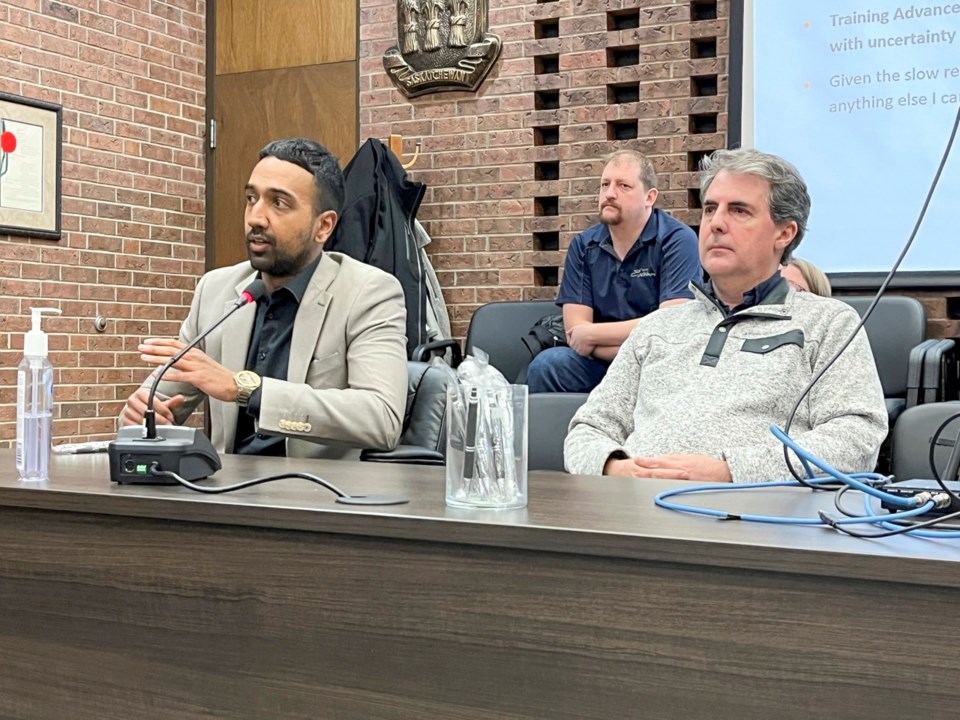ESTEVAN — The people who attended the Estevan Chamber of Commerce's latest Coffee Talk on Feb. 7 received an update on economic development on multiple fronts.
Angud Singh, who is the city's outgoing co-ordinator of economic development, and Gordon More, who is the executive director of the Southeast Techhub, talked about their recent efforts.
Singh noted they are working on trying to turn Estevan's lignite coal into graphite, which he said is part of their efforts to find other uses for coal. It has already been tested.
"So far everything is looking good. The next play would be to have a 12-kilowatt laser testing a larger sample of coal, ultimately with the goal of converting it to quality graphite in terms of yield and in terms of just overall composition."
The graphite could be used for lithium-ion batteries and other applications. Patents, licences and company structure would have to be ironed out.
The city is also looking at taking the yields from carbon capture and using it for formic acid, Singh said, and it is also promoting Estevan as the destination for the first small modular reactors (SMRs) in the province.
More said he and Tania Andrist, the applied research lead officer with the Southeast College, have formed an agreement for Innovation Centre, in which the college would be handling academic work like training and applied research. More would focus on business.
"We are now going out into the world and asking people to come here, big corporations as well as … start-ups. I'm focusing on the U.S. market," said More.
He's turning to the U.S. because of the size of its gross domestic product and the money spent on research and development. The focus is on energy generation, storage, transmission and transportation. The community knows a lot about the generation, but other elements aren't as familiar.
"A lot of the countries in the world are doing micro-grids, so with micro-grids, your farm, your business or your home has its own generation of power, you have your batteries and then you have a grid that oversees it," he said.
A plan was announced in June 2022 to have Buffalo Potash build a solution mining research and development facility. More said the lab will proceed and he has shown to the government that the lab is needed.
He has been working with an organization to add a 140-megawatt data centre, which is a server where computer systems and associated components are stored.
"Once they get the land and an agreement with SaskPower is sorted out, they'll have it up and running within 24 months. It is not new tech," said More.
During the question-and-answer session, city manager Jeff Ward addressed the recent controversy regarding the cost of the downtown revitalization project. A group called Concerned Citizens Estevan recently posted a video to YouTube, claiming the full cost of the project would be $40 million-$50 million.
Ward pointed out the city met with the Downtown Business Association on Feb. 6 to clarify some points on the video. He said the cost would be $33 million to do everything at once, but he stressed the city isn't doing everything at once.
Right now the city is looking at the 1100 and 1200 blocks of Fourth Street, which would cost $8.3 million, with most of it coming from the federal government. The city's contribution would be $1.5 million for underground utilities that need to be replaced anyway.
"The video that was put out did have a lot of the facts in it as you read through it, but I think the $40-$50 million scared a lot of people to start, but that was to build out the whole program, which is $33 million, and that would never happen all at one time. We wouldn't be able to afford it."
The two per cent property tax increase in this year's budget is not related to the downtown project.
The money, which is from the Canadian Coal Transition Initiative, is a fund that applies to coal communities for city infrastructure that increases business transportation or economic development.
Ward was asked about how this could affect the Estevan Market Mall and recent investment for the shopping centre. He noted the current mall owners are pleased with the mall and its location, it has good anchor tenants and they are looking forward to having the new food court finished. He added the mall supports the work downtown and wants to create more of an experience for shoppers, just like the city wants to do for downtown.
"You go, you park, you get your stuff and you leave for both the mall and downtown," said Ward. "And that's what both of these projects are trying to change, so that people go, they will mingle around both of them and then spend a little more dollars."
More pointed out tourist destinations like Whistler and Revelstoke in B.C. successfully revamped their respective communities. He also stressed that if Estevan wants physicians to stay, they need to give them a reason to remain with things like coffee shops and shopping destinations.
The city is continuing to work with LCE2 Energy out of England on a biomass project, which Ward said would turn agricultural waste into power. They have been working steadily on getting feedstock and a power purchase agreement with SaskPower. The federal government has also indicated biomass would fit under the federal government's clean energy standards.
Singh noted that economic development is a slow and steady process, and they hope their efforts will eventually pay off.
Ward encouraged those in attendance to ask city hall for updates on economic development.
"There is a lot of stuff that is pretty prime within two years, especially with the SMR announcements and the uses for coal," said Ward.



